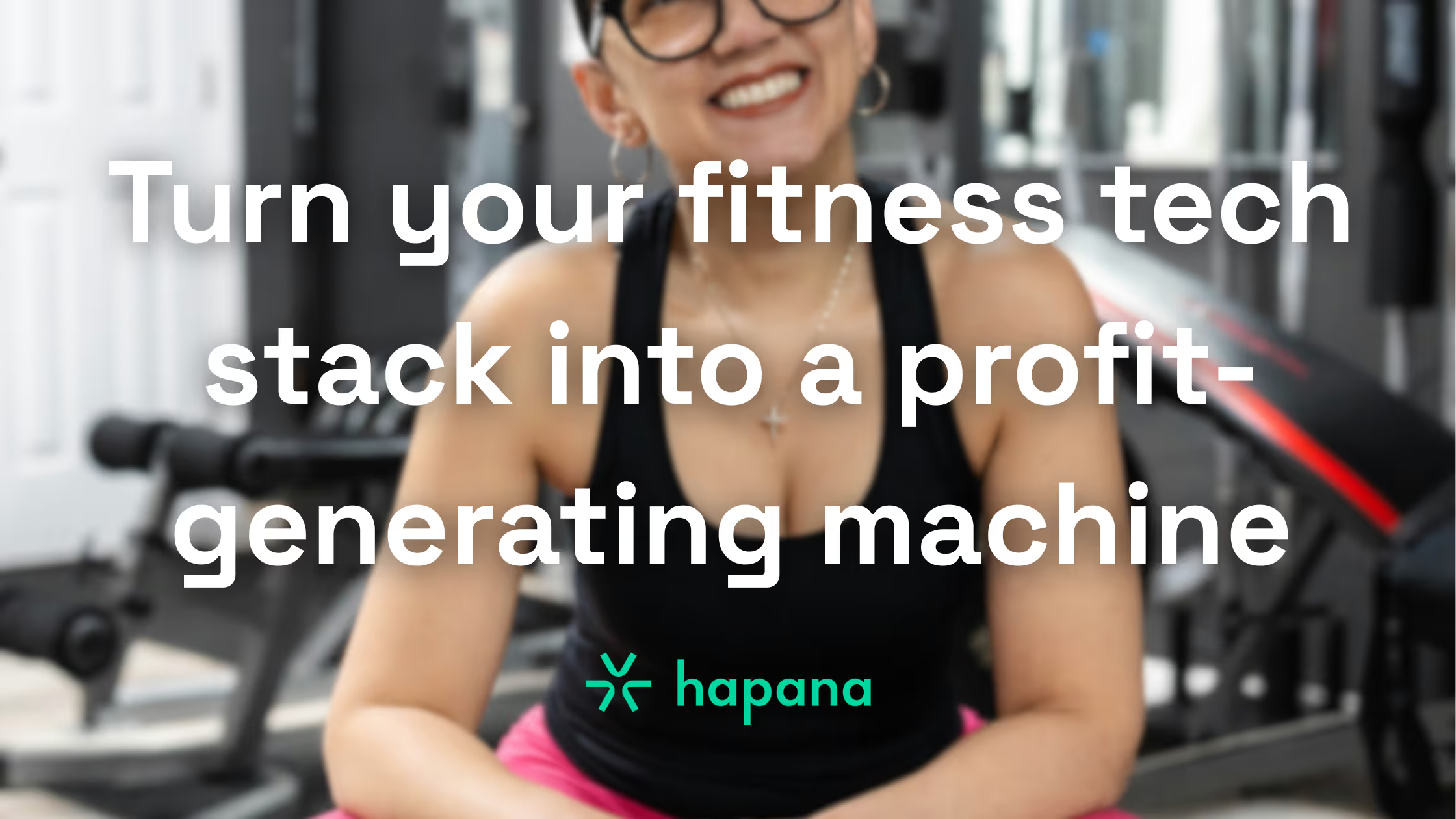
How to turn your fitness tech stack into a profit-generating machine

Investing in software is part and parcel of running a business, but do you write it off as an expense or view it as a means of creating revenue and profit?
In tech circles, they talk about making software a ‘profit centre’ rather than a ‘cost centre’ – we’ll disentangle what that really means as we go.
In some ways though, treating software as an expense is a learned response. Most business software, especially in the early days of SaaS, was designed to digitise manual processes rather than improve them.
You paid for a digital version of your filing cabinet or appointment book, not something that would actively grow your business.
Thankfully for all, things have moved on. Fitness software, in itself, has flourished as a category, offering a range of tools that bring intelligence to payments, marketing, scheduling, reporting, and everything else.
But there are still way too many imbalances and missed opportunities that prevent software from becoming that elusive ‘profit centre.’
What are the risks of treating tech as just an operational expense?
It’s tempting to treat software investments the same as a utility or insurance bill - find a cost-effective solution that ticks the boxes and call it a day. Once tools start stacking and overlapping, that can quickly get messy and expensive.
According to one study, companies are now managing an average of 275 SaaS applications with a combined spend of $8,700 per employee. 73% of employees don't use all their assigned licenses.
Why is this the case? Apart from taking out free trials and forgetting to cancel them (guilty), many software tools have incredibly narrow focuses. They excel at one specific task but exist in a vacuum. Or, they offer the functionality but fail to embed it in the fitness context, which is pretty unique.
You might end up with an old-school booking system that can't talk to your payment processors or handle complicated services and classes, marketing tools without connections to member data, and reporting tools that offer numbers without context.
Here’s how the impacts stack up:
- Revenue gets fragmented across providers: One system handles in-club memberships, another takes care of online programs, a third processes drop-ins or add-ons. Each one takes its cut in subs and fees. Functional at face value. Together, they cost you margin.
- Campaigns run without performance context: You push a membership offer, but the system can’t tell you whether those members showed up, booked, or stayed. Without behavioural data tied to payment and retention, your campaigns are shooting in the dark.
- Retention opportunities are missed: A member’s visits drop off. Payments start to fail. But without connected systems, those signals never surface in time. By the time someone notices, the member's already gone — and that’s revenue that could’ve been recovered.
- New revenue models get blocked at the setup stage: Want to test a recovery package, a challenge series, a flexi-membership, or a high-ticket program? Most legacy systems weren’t built for that kind of structure. So the idea either gets shelved or hacked together.
- Multi-site insights get lost in translation: As you grow, the question isn’t just “what’s working?” — it’s “what’s replicable?” If your systems can’t compare performance across locations in real time, using unified data, it’s guesswork.
How do you break out of this cycle? Stop thinking about software as a collection of individual, generic tools. Then start building an integrated system that works together to increase revenue and profit rather than taxing your bottom line.
How to make your fitness tech drive revenue and profit
Start with payment systems
Payments affect profit more directly than almost anything else in your operation. But they’re also full of friction points that quietly chip away at your margins.
What makes it worse? The customer is pre- or post-conversion, but the system blocks them or makes them jump through hoops. A card expires, and their membership lapses. A payment fails, and they can’t book until they call the front desk — super-frustrating.
These aren’t edge cases. They happen all the time. There’s a reason why failed payments cost businesses a collective $100 billion per year, according to a recent report.
We’ve built Hapana to actively reduce payment friction at every touchpoint, keeping revenue flowing without increasing overhead. Key features include:
- Future-dated single payments that trigger automatically on the right day
- Automated retries based on decline reason and member payment history
- Self-service updates for members to resolve failed payments without needing intervention
- Clear failed payment queue inside the dashboard for faster staff response
- In-app payment tracking so members can stay informed without clogging inboxes
- Custom payment options for upsells — recovery, retail, time-based packs — integrated directly into the billing flow
- Multiple payment channels and multi-currency support for scaling across locations or regions
And it works. A studio processing $50,000 a month can gain an extra $24,000 a year by raising its collection rate from just 92% to 96%. With a rock-solid payments system, that extra margin is simply built into your processes.
Since 2024, over half a billion dollars moves through the Hapana platform each year. That reflects stability, consistency, and fitness brands that trust their systems to handle revenue without leaks or blind spots.
Build marketing automations that convert prospects into revenue
Fitness marketing too often operates on wishful thinking: bulk emails, social media blasts, hope it lands. You can level up by deploying systems that understand both behaviour and demographics.
Hapana’s marketing automation tools capture leads from everywhere — website forms, social media, campaigns, even calls — and bring them into a unified view. From there, it gets tactical:
- Lead scoring to identify high-intent prospects early
- Behavioural triggers based on actions like booking pages, challenge sign-ups, or class RSVPs
- Conversion-friendly templates for SMS, WhatsApp, email, and social messaging
- Smart segmentation that groups leads by engagement pattern, not age or gender
- Automated win-back sequences targeting lapsed members with offers or content
These automations are built around timing and relevance. They pull in real member behaviour, reduce manual input, and keep prospects moving toward sign-up.
Hapana’s system creates a single source of truth, meaning marketing, payments, scheduling, and member behaviour all feed into each other. That reduces the risk of campaigns going cold because of siloed tools.
Use data to drive profitable decision-making and strategy
Most fitness businesses make decisions based on gut feeling.
Which channels work best? Which class formats drive the most engagement? Which pricing structures create sustainable member relationships? Don’t leave those questions hanging.
The answers lie in reports that surface actionable insights embedded within the fitness context:
- Which marketing channels bring in members who stay
- What time slots and class formats drive repeat attendance
- Where pricing models are over‑ or underperforming across locations
- Which members are showing early signs of disengagement
At Body Fit Training, where over 300 franchises operate across four countries, corporate-level reporting is what keeps their playbook scalable. As Scott Nathan put it: “To be able to get something that has the correct reporting dashboards and corporate-level insights has been super important.”
The same applies to boutique brands like Tribute Boxing, where retention depends on knowing the full member journey, from booking patterns to app engagement. Mari Mati said, “It’s all the little member experiences, and their journey in general, that keep our members around.”
Whether you're running five studios or fifty, decisions punch harder when they’re backed by data built for your model.
When your tech stack pays for itself (and keeps paying)
Once your new workflows begin to bed in, you start to notice the difference.
Bookings flow without issue. Payments don’t need chasing. Adding a new class type or membership option isn’t a whole project — it’s just part of the week. Reporting shows you what’s working, and what needs adjusting. And the team isn’t stuck fixing problems. They’ve got time to focus on what’s next.
When all of that begins to crystallise, the role of tech changes. It’s no longer there just to keep processes ticking over. It’s there to make decisions easier, and to help you move with more confidence.
That’s the point where it stops being an overhead — and starts helping you grow.
Book a demo of Hapana and we’ll show you what that looks like in practice.






.avif)
